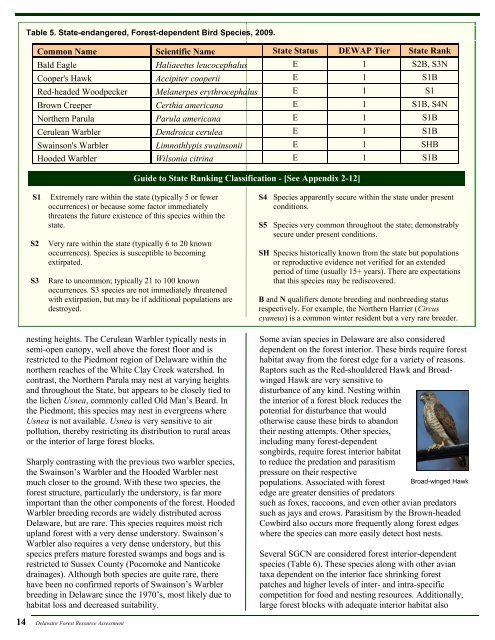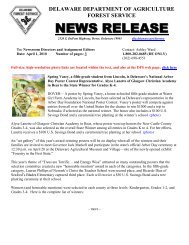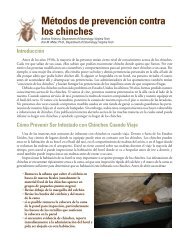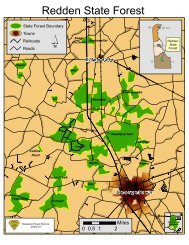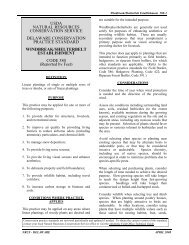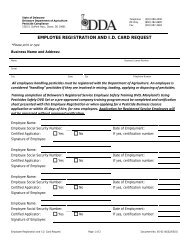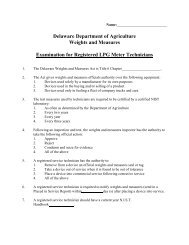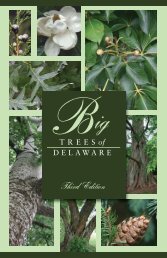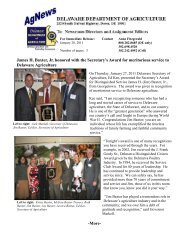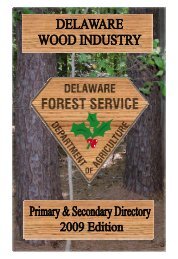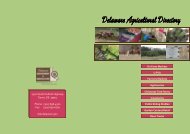DFS Resource Assessment - Delaware Department of Agriculture
DFS Resource Assessment - Delaware Department of Agriculture
DFS Resource Assessment - Delaware Department of Agriculture
You also want an ePaper? Increase the reach of your titles
YUMPU automatically turns print PDFs into web optimized ePapers that Google loves.
Table 5. State-endangered, Forest-dependent Bird Species, 2009.<br />
Common Name Scientific Name State Status DEWAP Tier State Rank<br />
Bald Eagle Haliaeetus leucocephalus E 1 S2B, S3N<br />
Cooper's Hawk Accipiter cooperii E 1 S1B<br />
Red-headed Woodpecker Melanerpes erythrocephalus E 1 S1<br />
Brown Creeper Certhia americana E 1 S1B, S4N<br />
Northern Parula Parula americana E 1 S1B<br />
Cerulean Warbler Dendroica cerulea E 1 S1B<br />
Swainson's Warbler Limnothlypis swainsonii E 1 SHB<br />
Hooded Warbler Wilsonia citrina E 1 S1B<br />
Guide to State Ranking Classification - [See Appendix 2-12]<br />
S1<br />
S2<br />
S3<br />
Extremely rare within the state (typically 5 or fewer<br />
occurrences) or because some factor immediately<br />
threatens the future existence <strong>of</strong> this species within the<br />
state.<br />
Very rare within the state (typically 6 to 20 known<br />
occurrences). Species is susceptible to becoming<br />
extirpated.<br />
Rare to uncommon; typically 21 to 100 known<br />
occurrences. S3 species are not immediately threatened<br />
with extirpation, but may be if additional populations are<br />
destroyed.<br />
S4 Species apparently secure within the state under present<br />
conditions.<br />
S5 Species very common throughout the state; demonstrably<br />
secure under present conditions.<br />
SH Species historically known from the state but populations<br />
or reproductive evidence not verified for an extended<br />
period <strong>of</strong> time (usually 15+ years). There are expectations<br />
that this species may be rediscovered.<br />
B and N qualifiers denote breeding and nonbreeding status<br />
respectively. For example, the Northern Harrier (Circus<br />
cyaneus) is a common winter resident but a very rare breeder.<br />
nesting heights. The Cerulean Warbler typically nests in<br />
semi-open canopy, well above the forest floor and is<br />
restricted to the Piedmont region <strong>of</strong> <strong>Delaware</strong> within the<br />
northern reaches <strong>of</strong> the White Clay Creek watershed. In<br />
contrast, the Northern Parula may nest at varying heights<br />
and throughout the State, but appears to be closely tied to<br />
the lichen Usnea, commonly called Old Man’s Beard. In<br />
the Piedmont, this species may nest in evergreens where<br />
Usnea is not available. Usnea is very sensitive to air<br />
pollution, thereby restricting its distribution to rural areas<br />
or the interior <strong>of</strong> large forest blocks.<br />
Sharply contrasting with the previous two warbler species,<br />
the Swainson’s Warbler and the Hooded Warbler nest<br />
much closer to the ground. With these two species, the<br />
forest structure, particularly the understory, is far more<br />
important than the other components <strong>of</strong> the forest. Hooded<br />
Warbler breeding records are widely distributed across<br />
<strong>Delaware</strong>, but are rare. This species requires moist rich<br />
upland forest with a very dense understory. Swainson’s<br />
Warbler also requires a very dense understory, but this<br />
species prefers mature forested swamps and bogs and is<br />
restricted to Sussex County (Pocomoke and Nanticoke<br />
drainages). Although both species are quite rare, there<br />
have been no confirmed reports <strong>of</strong> Swainson’s Warbler<br />
breeding in <strong>Delaware</strong> since the 1970’s, most likely due to<br />
habitat loss and decreased suitability.<br />
Some avian species in <strong>Delaware</strong> are also considered<br />
dependent on the forest interior. These birds require forest<br />
habitat away from the forest edge for a variety <strong>of</strong> reasons.<br />
Raptors such as the Red-shouldered Hawk and Broadwinged<br />
Hawk are very sensitive to<br />
disturbance <strong>of</strong> any kind. Nesting within<br />
the interior <strong>of</strong> a forest block reduces the<br />
potential for disturbance that would<br />
otherwise cause these birds to abandon<br />
their nesting attempts. Other species,<br />
including many forest-dependent<br />
songbirds, require forest interior habitat<br />
to reduce the predation and parasitism<br />
pressure on their respective<br />
populations. Associated with forest<br />
edge are greater densities <strong>of</strong> predators<br />
such as foxes, raccoons, and even other avian predators<br />
such as jays and crows. Parasitism by the Brown-headed<br />
Cowbird also occurs more frequently along forest edges<br />
where the species can more easily detect host nests.<br />
Broad-winged Hawk<br />
Several SGCN are considered forest interior-dependent<br />
species (Table 6). These species along with other avian<br />
taxa dependent on the interior face shrinking forest<br />
patches and higher levels <strong>of</strong> inter- and intra-specific<br />
competition for food and nesting resources. Additionally,<br />
large forest blocks with adequate interior habitat also<br />
14 <strong>Delaware</strong> Forest <strong>Resource</strong> <strong>Assessment</strong>


